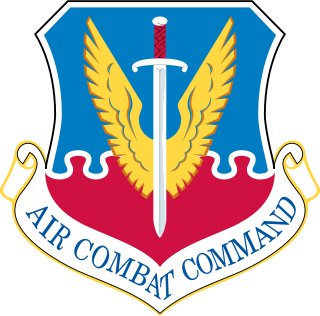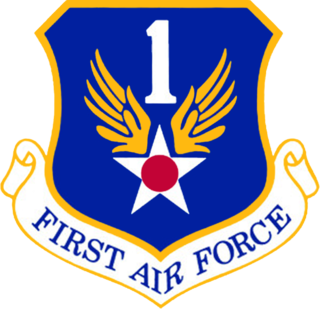
The Air Combat Command (ACC) is one of nine Major Commands (MAJCOMs) in the United States Air Force, reporting to Headquarters, United States Air Force (HAF) at the Pentagon. It is the primary provider of air combat forces for the Air Force, and it is the direct successor to Tactical Air Command. Air Combat Command is headquartered at Langley Air Force Base, Joint Base Langley–Eustis, Virginia, United States.

The First Air Force is a numbered air force of the United States Air Force Air Combat Command (ACC). It is headquartered at Tyndall Air Force Base, Florida. Its primary mission is the air defense of the Contiguous United States (CONUS), United States Virgin Islands and Puerto Rico. Since May 2022, it also provides the Air Force contribution to United States Space Command, as Air Forces Space (AFSPACE), including support functions for NASA human space flight.

The Fourth Air Force is a numbered air force of the Air Force Reserve Command (AFRC). It is headquartered at March Air Reserve Base, California.

The Sixteenth Air Force (Air Forces Cyber) (16 AF) is a United States Air Force (USAF) organization responsible for information warfare, which encompasses intelligence gathering and analysis, surveillance, reconnaissance, cyber warfare and electronic warfare operations. Its headquarters is at Joint Base San Antonio-Lackland in Texas.

Eighteenth Air Force (Air Forces Transportation) (18 AF) is the only Numbered Air Force (NAF) in Air Mobility Command (AMC) and one of the largest NAFs in the United States Air Force. 18 AF was activated on 28 March 1951, inactivated on 1 January 1958, and re-activated on 1 October 2003. 18 AF is headquartered at Scott Air Force Base, Illinois.
In military aviation, a wing is a unit of command. In most military aviation services, a wing is a relatively large formation of planes. In Commonwealth countries a wing usually comprises three squadrons, with several wings forming a group. Each squadron will contain around 20 planes.
A group is a military unit or a military formation that is most often associated with military aviation.

The Air Force Materiel Command (AFMC) is a Major Command (MAJCOM) of the United States Air Force (USAF). AFMC was created on July 1, 1992, through the amalgamation of the former Air Force Logistics Command (AFLC) and the former Air Force Systems Command (AFSC).
A Numbered Air Force (NAF) is a type of organization in the United States Air Force that is subordinate to a major command (MAJCOM) and has assigned to it operational units such as wings, squadrons, and groups. A Component Numbered Air Force (C-NAF) has the additional role as an Air Force Component Command exercising command and control over air and space forces supporting a Unified Combatant Command. Unlike MAJCOMs, which have a management role, a NAF is a tactical organization with an operational focus, and does not have the same functional staff as a MAJCOM. Numbered air forces are typically commanded by a major general or a lieutenant general.

The Cyberspace Capabilities Center (CCC), located at Scott Air Force Base, Illinois, is the primary organization that develops cyber domain requirements in the United States Air Force.
In the United States Air Force, a division was an intermediate level of command, subordinate to a numbered air force, controlling one or more wings. It also controlled squadrons without associated same-function wings, i.e., 17th Defense Systems Evaluation Squadron had no associated wing, but its function was part of the 24th Air Division. Divisions are now considered obsolete.
In the United States Marine Corps, a Marine Air–Ground Task Force is the principal organization for all missions across the range of military operations. MAGTFs are a balanced air–ground, combined arms task organization of Marine Corps forces under a single commander that is structured to accomplish a specific mission. The MAGTF was formalized by the publishing of Marine Corps Order 3120.3 in December 1963, "The Marine Corps in the National Defense, MCDP 1-0". It stated:
A Marine air–ground task force with separate air ground headquarters is normally formed for combat operations and training exercises in which substantial combat forces of both Marine aviation and Marine ground units are included in the task organization of participating Marine forces.

The 927th Air Refueling Wing is a combat coded Air Reserve Component (ARC) wing of the United States Air Force. It is assigned to the Fourth Air Force of Air Force Reserve Command (AFRC) and is stationed at MacDill Air Force Base, Florida.
The structure of the United States Air Force refers to the unit designators and organizational hierarchy of the United States Air Force, which starts at the most senior commands.

The Air Force Global Strike Command (AFGSC) is a Major Command (MAJCOM) of the United States Air Force, headquartered at Barksdale Air Force Base, Louisiana. AFGSC provides combat-ready forces to conduct strategic nuclear deterrence and global strike operations in support of combatant commanders. Air Force Global Strike Command is the Air Force's service component to the United States Strategic Command (USSTRATCOM).

The United States Air Force's 251st Cyberspace Engineering Installation Group is an Air National Guard engineering installation unit located at Springfield ANGB, Ohio. It is the oldest communications/cyber group in the USAF and was originally chartered at the 251st Mobile Communications Group. The units assigned to the 251CEIG compromise 47.5% of the USAF's Engineering Installation capability and 47.5% of Department of Defenses Build and Extend Organic cyberspace infrastructure robust capability. The co-located 269th Combat Communications Squadron is also assigned to the 251st and is the USAF's Oldest Mobile Communications Squadrons rooted as the 1077th Signal Company Army Air Corps founded in March 1942. The Group Headquarters has 38 personnel assigned with a wartime mission to augment Major Command AFFOR staffs, Joint Force Commander staffs, Numbered Air Forces Warfighting Headquarters staffs or any Combatant Commanders cyber and Communications forward staff function.
The Hobson Plan was an organizational structure established by the United States Air Force (USAF) in 1948, following experimental organization in 1947. Known as the "Wing-Base Organization," it replaced the organization used by the United States Army Air Forces (AAF), the predecessor organization of the USAF, which used separate chains of command for combat and support units. The plan made the wing the basic combat unit of the AAF, rather than the group and placed all support elements on a base under the command of the wing commander in addition to combat elements.

The United States Space Force is organized by different units: the Space Staff, the field commands, and the space deltas.




















































